About Dyslexia

What is dyslexia?
Dyslexia occurs in about 10% to 20% of the population. It is when there is a difference in activity in the left side of the brain (compared to non-dyslexic individuals) when doing certain language based activities, especially reading. The picture shown above, as seen by an fMRI, illustrates how, during a reading task, the left hemisphere of a dyslexic brain, lights up more in one area when compared to a non-dyslexic brain. It is very likely that this is why people who have untreated dyslexia tire easy when attempting to read; their brain is working much harder. Also, the non-dyslexic brain has activity in other areas (to the side and back) which may be associated with visualization of what is being read as well as comprehension. The dyslexic individual is missing out on these key components of reading since they are too busy struggling with basic decoding.

Diagnosing Dyslexia - Does My Child Have Dyslexia?
In the past, a discrepancy between IQ and reading level was
used to diagnose children as having dyslexia. If a child had an average or above
average IQ and could not read as well his or her peers, this raised a flag, and
the child would be identified as being dyslexic. The children, with lower IQs,
would not normally be diagnosed as having dyslexia, since they did not meet the
intelligence standard required. Today, this idea is changing, due to the use of
fMRIs in the study of dyslexia (see below "Low IQ and Dyslexia").
Dyslexia is a language based disorder that runs in
families. Often children who are dyslexic will need speech therapy, and
later will encounter problems learning to read.
In addition, those that are dyslexic often reverse letters and numbers that
are the same shape, such a 'b' and 'd'. If a child is reversing letters or
numbers after age 8 and is not reading at grade level, despite adequate
instruction, then there is a probability that he or she is dyslexic. If
he/she had speech problems and/or a family member who is dyslexic, then the
probability increases. To obtain a professional dyslexia diagnose,
people often have their children tested by a neuropsychologist.

How to Treat Dyslexia
Studies have shown that after using an intensive, structured phonics reading program, students who were identified as having dyslexia, as well as those poor readers with low IQs, showed significant improvement in reading. In fact, according to Shalini Narayana, PhD, and Jinhu Xiong, PhD, after remediation, brain scans of dyslexic students during a reading task (using a fMRI), showed little to no difference from that of normal readers. Today, most reading programs for dyslexia follow the Orton-Gillingham approach. This has been used for decades, has been tested, and is proven to be the most effective treatment for dyslexia. Read more about the Orton-Gillingham approach.
Low IQ and Dyslexia
According to Emily Finn, of MIT News Office, and researchers at the
Stanford University School of Medicine, children with lower IQs, who also struggle
with reading, have very similar brain scans during a reading task as those children with higher IQs who were labeled as having dyslexia.
Because of this, there is currently a movement to eliminate using IQ for identifying dyslexia, and to give an intensive phonics intervention to both groups.
As seen in the research done by Jill Allor and Tammi Champlin (Institute for Reading Research Southern Methodist University) in their
study "Response to Reading Intervention by Students with Low IQs",
students with ID (intellectual disabilities or IQ scores in the borderline
range) and those with IQs in the moderate range, can learn basic reading
skills given consistent, explicit, and comprehensive reading instruction
across an extended period of time. Although improvement was evident,
it is important to note that the rate of improvement for these students was slower.
Learn More About Our Reading Programs for Your Student's Age!

Signs of Dyslexia
Usually schools will wait until a child is a year or two behind in reading before they will test for any type of learning disability. This will allow them to rule out maturity issues (such as letter reversals) and give them time to have a clear idea and understanding of the problem. Parents often feel that waiting this long is detrimental to the child and should be avoided. Parents can take the necessary steps themselves to identify dyslexia and begin reading remediation, whether they hire a tutor or do it themselves. Below are the signs to look for.

Early Years, 4-5
- Language issues: Children who have dyslexia often learn to talk later than other children and often have issues with language which would require a speech therapist. The issues are not due to physical aspects such as poor muscle development, but rather due to poor phoneme awareness, where putting simple sounds together, such as the 'sm' in "smile", are difficult.
- Trouble rhyming words: Due to poor phoneme awareness, dyslexic children often have trouble rhyming words and identifying similar sounds.
- Issues with memory: Some dyslexic children have a very poor working memory when it involves verbal information, however, if the information is visual, then the child excels. They may, for example, have trouble memorizing the days of the week, words to songs, or following (verbal) instructions and yet have amazing skills with puzzles.

Middle Years, 6-10
- Letter reversals: Letter reversals are very common in children up to age 8, which is why it isn't usually used to identify dyslexia in young children. Typically, dyslexic people will reverse letters/numbers such as: 'b' and 'd', 'p' and 'q' and '6' and '9'. Sometimes the child will write a capital letter, instead of lowercase, when they are unsure, such as "numBer". If your child is over the age of 8, is behind in reading and reverses letters and/or numbers, it is very possible that your child has dyslexia. Click here to read more about reversals and dyslexia.
- When reading, a dyslexic child may skip or change words, even the small simple (high frequency) words.
- When reading, they may substitute words that have the same or similar meanings, i.e. they may see the word "hut", but may say "house".
- When reading, they often guess at a word, often using the first few letters as their "clue", i.e. if they see "caption", they may say "captain" (the sounds are not followed through to the entire word).
- When reading, they may mix up letters within words, such as "form" to "from".
- When writing, they may omit prefixes or suffixes.
- In the classroom, they may have trouble copying from the board or taking notes.
- They may not write sounds from left to right; for example the word "to" may be written as "ot".
- hey may have trouble memorizing facts. Visual cues, stored in the right side of the brain, often help memorization.
- They may have trouble learning to tell time on an analog clock.
- Sometimes they may be ambidextrous, or use one hand for writing, while using the other for a different task.

Later Years, 10 to Adult
- An older dyslexic person, who has not yet been taught to read using a system specifically for dyslexia, often has poor writing skills. Writing may be simplistic and handwriting is often messy with many spelling errors and poorly constructed sentences.
- Older students will often take poor classroom notes.
- When speaking, they may be unable to easily find a word when formulating sentences, sometimes resulting in jumbled words.
- Older dyslexic people usually avoid reading out loud, and when reading they often read in a monotone voice with no inflection.
- Dyslexic people often have difficulty learning a foreign language.
Learn More About Our Reading Programs for Your Student's Age!













